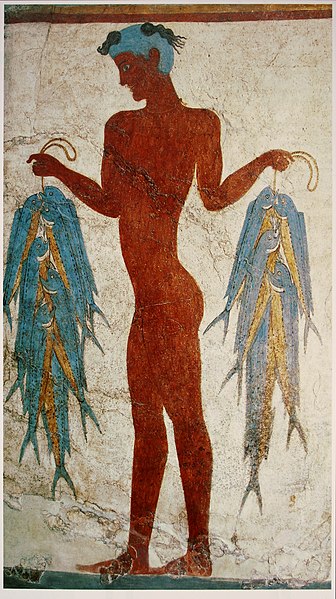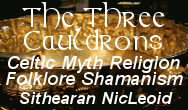Ariadne's Tribe: Minoan Spirituality for the Modern World
Walk the sacred labyrinth with Ariadne, the Minotaur, the Great Mothers, Dionysus, and the rest of the Minoan family of deities. Ariadne's Tribe is an independent spiritual tradition that brings the deities of the ancient Minoans alive in the modern world. We're a revivalist tradition, not a reconstructionist one. We rely heavily on shared gnosis and the practical realities of Paganism in the modern world. Ariadne's thread reaches across the millennia to connect us with the divine. Will you follow where it leads?
Find out all about Ariadne's Tribe at ariadnestribe.com. We're an inclusive, welcoming tradition, open to all who share our love for the Minoan deities and respect for our fellow human beings.
The Colors of Minoan Life and Art
The Minoans loved color. The vibrant colors are usually the first thing people notice about Minoan art; the second thing they notice is how natural and realistic much of it is.
That naturalism and realism might lead people to wonder about some of the color conventions in Minoan art. So much of Minoan art is realistic, it's kind of jarring when something is the wrong color.
If you have a look at the Bull Leaper fresco at the top of this post, you'll see that the two athletes to the right and left have white skin (not a natural Caucasian peachy color or a natural light tan, but literally white). The central bull leaper is a deep reddish tan, like a bad sunburn.
This is due to a set of rules in Minoan art that says women always have white skin and men always have reddish tan skin. These colors have symbolic significance, so they're more than just an artistic convention.
This rule about skin color makes Minoan art more interesting to look at, since the people aren't all the same, and it also gives us interesting information about their lives. For instance, now you know that two of the athletes in that famous Bull Leaper fresco are female. That's right. Women bull-leapers.
How about these frescoes from Akrotiri. Here's a young fisherman with a plentiful catch:

And some boys boxing, with padded gloves on the right hand only:

And a couple of monkeys, er, monkeying around:

Do you notice anything about the colors in these frescoes? Objects and surfaces that are gray in real life are shown as blue in Minoan art: shaved skin, fish, monkey fur.
It's not that the Minoans were incapable of making gray paint. They had black and white pigments, so they could also make gray. But apparently they considered blue more visually appealing. It may also have had symbolic significance, the way the red and white skin do. There's also the possibility that it was a wealth display, since the blue pigments available in the Bronze Age Mediterranean (powdered lapis lazuli and Egyptian blue) were very expensive. More about these below.
Here again, the colors tell us something about Minoan life.
The young fisherman and the boys who are boxing all have shaved heads with only a forelock (bangs/fringe) and a ponytail or two left to grow long. In many ancient cultures, children's heads were shaved to control lice (and honestly, as a mom myself, I bet ease of care had something to do with it as well - there are only so many mornings a person can stand to fight with their child about all that tangled hair!).
The boxers in the fresco above are obviously young boys, but it's hard to tell the fisherman's age from his physique. Lucky for us, his hair tells the story. Minoan adults had long or chin-length hair that wasn't shaved in any way, so we know this young man isn't a full adult yet. Maybe he'll have his coming-of-age rite soon.
Minoan art is so colorful. Where did they get their colors from? Mostly from nature.
The red, yellow, white, and black in the frescoes come from pigments that people have used since the Stone Age all over the world: red ochre, yellow ochre, limestone/white clay, and coal/soot. You see these same pigments in the marvelous cave art from southern Europe, South Africa, and western North America. These colors appear in Minoan frescoes and also as designs on Minoan pottery.
Blue is a different story. It's hard to find clear, bright blue in nature and even harder to find natural materials that will give that color in finished art. On rare occasions, the Minoans used powdered lapis lazuli to make blue paint for their frescoes. But then as now, that's prohibitively expensive.
There's an iron ore called vivianite that sometimes turns up as a dull blue, like the shaved heads and monkey fur in those frescoes above. But it's a grayish blue, not particularly striking. Where did the Minoans get the vibrant shades of blue they used in works like the Bull Leaper fresco?
The stuff the Minoans used most of the time to make bright blue in their art was a man-made pigment called Egyptian blue. I'm sure they paid a pretty penny for it, since the Egyptians weren't keen to give up their secret recipe. But the Minoans and the Egyptians were major trading partners, so I suspect the Egyptian blue flowed into Crete pretty easily in exchange for the bronze blades, painted pottery, jewelry, and other goodies the Minoans created.
So the next time you happen to look at Minoan art, think about the colors - what they mean, where they came from. And of course, enjoy the beauty of it all.
Comments
-
Please login first in order for you to submit comments




















